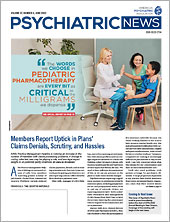Study Questions Link Between Inflammation, Late-Life Depression
Late-life depression alone does not lead to elevated inflammation, suggests a report published in Translational Psychiatry.
Though previous studies have pointed to a link between late-life depression and inflammation, few of these studies controlled for comorbid medical conditions also associated with inflammation.
Investigators at the University of Pennsylvania and colleagues recruited 66 adults aged 50 or older who had major depression but no other medical conditions associated with systemic inflammation (for example, an autoimmune disease). This sample was matched with 26 older adults without depression or inflammatory conditions. The adults with depression were randomized to receive escitalopram, escitalopram plus celecoxib (an anti-inflammatory drug), or placebo for eight weeks.
The investigators analyzed the concentration of 29 different inflammatory molecules in the blood of the participants at baseline and found no differences between the adults with and without depression. After eight weeks, average levels of inflammatory molecules among all participants remained unchanged, despite significant improvements in depressive symptoms among the adults with depression. Though adults who took escitalopram alone or escitalopram in combination with celecoxib had statistically better improvements in depressive symptoms than those taking placebo, there were no differences between the two medication groups.
“Our findings … make the important point that inflammation is not an intrinsic component of depression and [should] prompt further consideration of personalized therapeutic approaches for [major depression] in which both inflammation and depression are addressed,” the investigators wrote.
Veterans With PTSD Report Memory Improvements Following Ketamine
Ketamine can help to alleviate symptoms of comorbid depression and posttraumatic stress disorder (PTSD), but some have questioned whether such treatment may result in neurocognitive problems. A small study in the Journal of Affective Disorders now suggests that repeated doses of ketamine do not significantly worsen cognitive function in veterans with comorbid depression and PTSD.
Researchers at the University of Minnesota Medical School and colleagues provided six ketamine infusions to 15 veterans with comorbid depression and PTSD over 12 days. The participants’ PTSD and depression symptoms were assessed before and after each infusion, while cognitive assessments were conducted at the start of the study and one week after the last ketamine infusion.
Compared with baseline assessments, the participants demonstrated a significant improvement in working memory after ketamine infusions. The researchers also found that veterans with lower scores on working memory or processing speed at baseline showed greater improvements in both depression and PTSD symptoms following ketamine treatment.
The researchers noted that deficits in working memory and processing speed seen in patients with PTSD may result from overactivation of the amygdala, which directs the brain’s resources toward threat detection and other emotional processes.
“Ketamine infusions may promote recovery from PTSD symptoms by enabling appropriate allocation of cognitive resources to non-threat related tasks,” they wrote.
Alcohol Prevention Programs Found to Have Lasting Effects
A seven-year follow-up of high school students enrolled in a study on alcohol prevention programs found that both a Web-based program for all students or an in-person program for high-risk youth can offer lasting benefits. As noted in the Journal of the American Academy of Child and Adolescent Psychiatry, however, providing both alcohol prevention programs in the same school offered no additional benefit.
These findings were from the Climate and Preventure trial, a study initiated in Australia in 2012 among eighth graders (average age, 13 years) at 26 Australian secondary schools. The schools were randomized to one of four groups: (1) offered students twelve 40-minute lessons of Climate, a universal Web-based alcohol use prevention program; (2) offered students two 90-minute group sessions of Preventure, a prevention program tailored to youth who met personality criteria for high-risk of substance use; (3) offered students both Climate and Preventure; or (4) offered students the school’s usual health education. The study and follow-up were conducted by researchers at the University of Sydney and colleagues.
About half of the original participants, who were now of legal drinking age in Australia, completed the seven-year follow up assessments. After seven years, the participants in each of the three prevention groups reported similar lower odds of alcohol-related problems (for example, went to work or school drunk and/or got in fights when drinking) compared with those receiving usual health education. Youth in the Climate or Preventure groups (but not the combined group) were also less likely to report hazardous drinking after seven years.
“The durability of alcohol prevention effects over a seven-year period speaks to the value of school-based prevention initiatives, which, for a relatively modest investment of time and resources, continue to deliver benefits long after implementation,” the researchers wrote.
Study Highlights Factors Key to Well-being In Adults With ADHD
Over 40% of adults with attention-deficit/hyperactivity disorder (ADHD) living in Canada reported feelings of life satisfaction and psychological well-being when surveyed by researchers at the University of Toronto. The results, published in the International Journal of Applied Positive Psychology, also identified factors that may promote these positive outcomes.
This study “makes a significant contribution to the literature on adults with ADHD by identifying factors associated with flourishing in this population, shifting away from the deficit-focused perspective that is frequently used in ADHD research,” the researchers wrote.
The findings were drawn from 21,099 respondents to the 2012 Canadian Community Health Survey-Mental Health, a nationally representative survey assessing the mental health status and related factors of Canadian adults; the sample included 480 adults with diagnosed ADHD.
The researchers first calculated how many adults achieved complete mental health, which they defined as the absence of any other mental illness or substance use disorder (other than ADHD) in the past year and presence of consistent emotional and social well-being over the past month. Overall, 42% of adults with ADHD reported complete mental health, compared with 74% of adults without ADHD.
Among adults with ADHD, those who were married, physically active, and/or used spirituality to cope with challenges were more likely to experience complete mental health. In contrast, adults who experienced childhood abuse, debilitating pain, or had a history of depression or anxiety were less likely to achieve complete mental health.
“This [study] can help guide clinicians towards modifiable factors for improving mental health among those with ADHD, such as improving physical activity and social support, and treating symptoms of comorbidities, such as chronic pain, depression, and anxiety,” the researchers concluded.
Movement Tracking May Identify Severity of Negative Schizophrenia Symptoms
Passively tracking the movements of people with schizophrenia (via their smartphone and/or smart bands) may offer some clues about the negative symptoms they are experiencing, reports a study in Schizophrenia.
Researchers at the University of Georgia and colleagues collected accelerometry data from 50 individuals with schizophrenia or schizoaffective disorder and 70 participants without any psychiatric disorder (matched by age, sex, and race) over six days. All participants were provided the same Android phone and fitness band to ensure the comparability of the data. The participants with schizophrenia also completed numerous clinical assessments at baseline to assess severity of different symptoms.
The participants with schizophrenia showed significantly lower levels of daily average steps (movement vigor) and less day-to-day difference in steps (movement variability) than the control participants. The researchers also found that participants with the lowest vigor and variability rates reported higher baseline levels of negative schizophrenia symptoms. There was no correlation between accelerometry data and positive symptoms severity, degree of disorganized thinking, or overall symptom severity.
“While [accelerometry] may hold promise, methodological considerations are warranted. Until further validity is demonstrated and it is determined whether band or phone collection (or both in tandem) is most ideal, clinical trials may want to use [accelerometry] as a secondary or exploratory outcome measure,” the researchers wrote. ■





